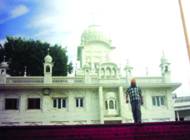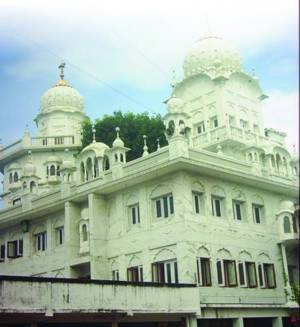Gurudwara Damdama Sahib, Dhubri (Assam)


Dhubri in Assam was sanctified by the visit of Guru Nanak and Guru Tegh Bahadur. During his stay in Dhubri, the ninth Guru received the news that a son was born to him at Patna. This son was Gobind Rai who later became the most respected tenth Guru popularly known as Sri Guru Gobind Singh. He succeeded Guru Gaddi after the execution of his father in Chandni Chowk, Delhi by the order of Emperor Aurangzeb in 1675.
The historic shrine Damdama Sahib at Dhubri in Assam was built in memory of the visit of Guru Nanak. Hence it has great importance for the Sikh community.

According to history and legend, Guri Tegh Bahadur visited Assam in 1670. He had accompanied Raja Ram Singh of Amber who had been sent by Aurangzeb to quell a rebellion by the Ahom Chief Chakradhwaj. Assam was a difficult country to operate in and for Raja Ram Singh it was a task assigned to him as a punishment because it was from his custody that Shivaji had escaped a few years earlier. Guru Tegh Bahadur’s presence, therefore, was a moral booster to him and his troops. The Guru’s role was, however, more active than a mere presence. The pacifist that he was, he helped conclude a no-war agreement between the two sides. As a monument to peace, a high mound was raised to which every soldier contributed five shieldfuls of earth. This mound, standing on the bank of the Brahmpra River at Dhubri, in Goalpara district of Assam, came to be treated as a sacred shrine.
A Gurudwara was also built near it on the spot where Guru Tegh Bahadur had stayed and negotiated peace. It was looked after by Udasi priests until it was destroyed in an earthquake in 1896-97 circa. Bhai Ram Singh, an official of the shrine, reconstructed a room in 1901. The Mahants also possessed a Farman (fiat) of a Mughal emperor pertaining to a land grant to the shrine. In 1902-03, Mahant Jai Singh took this Farman with him when he went to Punjab to raise funds through donations for the Gurudwara building under reconstruction. Unfortunately Bhai Jai Singh died somewhere near Amritsar, and the Farman was lost.
In 1966, Gurudwara Thara Sahib or Damdama Sahib in a small octagonal hut with a sloping roof was also set up on top of the mound. It is called Thara Sahib or Damdama Sahib.
Another shrine called Gurudwara Sri Guru Tegh Bahadur is in a square hall with wooden walls and a sloping roof.


